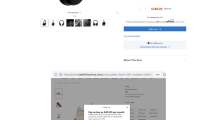Abstract
We demonstrate with a grim trigger strategy that the small firm should be more willing to collude tacitly as its market share declines; large firms should be less willing to cooperate. The small firm is not a maverick. The intensity of rivalry between two firms with asymmetric market shares is studied in experimental markets. Treatments give duopolists (1) 50% shares, (2) a 60 or 40% share, and (3) an 80 or 20% share. Choices for the small firm in the latter treatments are not significantly larger than the collusive choice. Irrespective of relative size, firms in all three market environments exhibit collusive behavior.
Similar content being viewed by others
References
Ashenfelter O., Currie J., Farber H. S., Spiegel M. (1992) An experimental investigation of dispute rates in alternative arbitration systems. Econometrica 60: 1407–1433
Baker J. B. (2002) Mavericks, mergers, and exclusion: Proving coordinated competitive effects under the antitrust law. New York University Law Review 77: 135–203
Breunig R., Menezes F. (2008) Empirical approaches for identifying maverick firms: An application to mortgage providers in Australia. Journal of Competition Law and Economics 4: 811–836
Carlton D. W., Perloff J. M. (2005) Modern industrial organization. Pearson/Addison Wesley, Boston
Fouraker L., Siegel S. (1963) Bargaining behavior. McGraw Hill, New York
Friedman J. (1983) Oligopoly theory. Cambridge Press, New York
Friedman J. (1986) Game theory with applications to economics. Oxford Press, New York
Harrington J. (1989) Collusion among asymmetric firms: The case of different discount factors. International Journal of Industrial Organization 7: 289–307
Kwoka J. E. Jr. (1989) The private profitability of horizontal mergers with non-Cournot and maverick behavior. International Journal of Industrial Organization 7: 403–411
Mason C. F., Phillips O. R. (1997) Information and cost asymmetry in experimental duopoly markets. Review of Economics and Statistics 79: 290–299
Mason C. F., Phillips O. R. (2002) In support of trigger strategies: Experimental evidence from two-person non-cooperative games. Journal of Economics & Management Strategy 11: 685–716
Mason C. F., Phillips O. R., Nowell C. (1992) Duopoly behavior in asymmetric markets: An experimental evaluation. Review of Economics and Statistics 74: 662–670
Noussair C. N., Plott C. R., Riezman R. G. (1995) An experimental-investigation of the patterns of international trade. American Economic Review 85: 462–491
Rasmusen E. (1989) Games and information: An introduction to game theory. Blackwell, Oxford, UK
SAS: (1993) SAS/ETS User’s Guide. SAS Institute Inc., Cary, NC
Schmalensee, R. (1989). Inter-industry studies of structure and performance. In Handbook of industrial organization (Vol. II, pp. 952–1009). Amsterdam: North Holland).
US Department of Justice and Federal Trade Commission. (2010). Horizontal merger guidelines (Washington, DC).
Author information
Authors and Affiliations
Corresponding author
Rights and permissions
About this article
Cite this article
Phillips, O.R., Menkhaus, D.J. & Thurow, J.N. The Small Firm in a Quantity Choosing Game: Some Experimental Evidence. Rev Ind Organ 38, 191–207 (2011). https://doi.org/10.1007/s11151-011-9277-9
Published:
Issue Date:
DOI: https://doi.org/10.1007/s11151-011-9277-9




